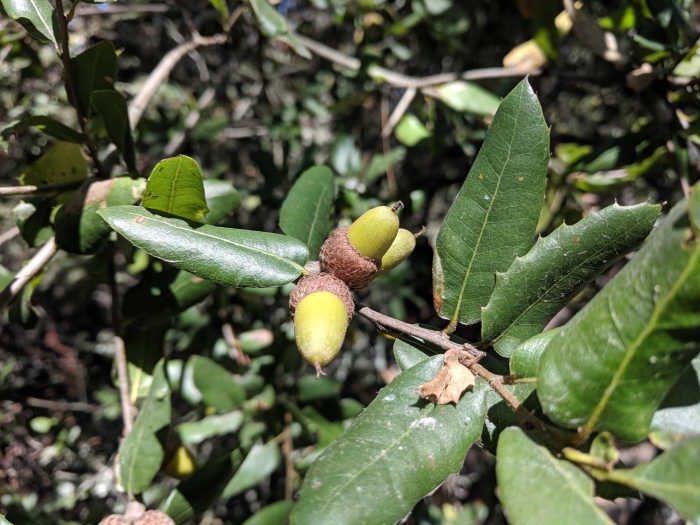Interior Live Oak
(Quercus wislizeni)
Interior Live Oak (Quercus wislizeni)
/
/

joergmlpts
CC BY 4.0
Image By:
joergmlpts
Recorded By:
Copyright:
CC BY 4.0
Copyright Notice:
Photo by: joergmlpts | License Type: CC BY 4.0 | License URL: http://creativecommons.org/licenses/by/4.0/ | Rights Holder: joergmlpts | Publisher: iNaturalist | Date Created: 2019-08-27T13:03:04-07:00 |



























































Estimated Native Range
Summary
Quercus wislizeni, commonly known as Interior Live Oak, is an evergreen tree or large shrub native to the chaparral, woodlands, and lower montane forests of California and Baja California, Mexico. It exhibits a high degree of variability in form, often appearing shrubby in harsher environments. Typically, it grows to 22 meters (72 feet) tall, but in the low-elevation Sierra Nevada foothills, it more commonly reaches up to 10 meters (33 feet). The foliage consists of dark-green leaves that can appear grayish from a distance, usually measuring 2–5 centimeters (1–2 inches) in length. These leaves are thick and may be spiny-toothed, especially at higher elevations or on younger trees. The acorns of Interior Live Oak are 1–2 cm (1⁄2–1 inch) long and mature in the second season after flowering, approximately 18 months.
Interior Live Oak is valued for its drought tolerance and ability to thrive in full sun to part shade conditions. It is well-suited for xeriscaping and is often used in native plant gardens, as well as for stabilizing slopes due to its deep root system. While it requires minimal water once established, it does best in soils with medium drainage. Gardeners should be aware that the acorns and leaves can create litter, and the tree’s dense canopy may require occasional thinning to maintain health and structure.CC BY-SA 4.0
Interior Live Oak is valued for its drought tolerance and ability to thrive in full sun to part shade conditions. It is well-suited for xeriscaping and is often used in native plant gardens, as well as for stabilizing slopes due to its deep root system. While it requires minimal water once established, it does best in soils with medium drainage. Gardeners should be aware that the acorns and leaves can create litter, and the tree’s dense canopy may require occasional thinning to maintain health and structure.CC BY-SA 4.0
Plant Description
- Plant Type: Trees
- Height: 8-65 feet
- Width: 8-65 feet
- Growth Rate: Slow
- Flower Color: N/A
- Flowering Season: Spring
- Leaf Retention: Evergreen
Growth Requirements
- Sun: Full Sun, Part Shade
- Water: Low
- Drainage: Medium
Common Uses
Bee Garden, Bird Garden, Butterfly Garden, Drought Tolerant, Fire Resistant, Low Maintenance, Rabbit Resistant
Natural Habitat
Native to the chaparral, woodlands, and lower montane forests of California and Baja California, Mexico
Other Names
Common Names: Sierra Live Oak
Scientific Names: Quercus wislizeni
GBIF Accepted Name: Quercus wislizeni A.DC.